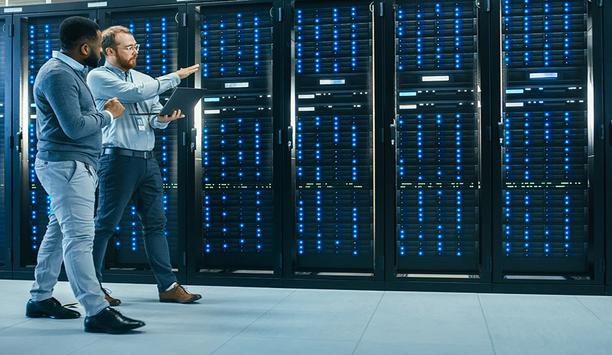What will be the biggest security trends in 2021?
Editor Introduction
We are several weeks into 2021, and it is already shaping up to be an eventful year. The happenings and trends from 2020 will likely carry over into the new year, but in a fast-moving industry such as ours, there will also be additional trends to watch. Looking toward the year ahead, we asked this week’s Expert Panel Roundtable: What will be the biggest security trends in 2021?
Businesses will continue to expand the role of their physical security systems to go beyond traditional applications and deliver more value. Public and private organizations will also put renewed focus on privacy protection. Rather than hindering the development of new technologies, privacy will prove to be a driving force in the pursuit of responsible and innovative design. With the shift to remote work, the traditional “secure” IT perimeter no longer exists, and cybersecurity risks will continue to rise. With little certainty on when people can resume “normal” office life, organizations will need to take decisive steps to strengthen their cyber posture. We will also see a greater emphasis on choosing trusted vendors. End users, especially in the enterprise space, will rightfully scrutinise their supply chain. In the coming year, physical security leaders will be encouraged to let go of the false division between cloud and on-premises systems and embrace a hybrid model.
Several tailwinds will drive growth in the smart home security market in 2021. The pandemic has increased focus on protecting the things we care about, in and around our homes. The housing market shows signs of continued strength, driven in part by homebuyers relocating to suburbs and record-low mortgage rates. Homeowners are investing in home improvement, specifically in protecting their family and property. The smart home buyer requirements continue to mature and include a unified, easy to use the system on a single platform; more complete systems including integrated panels, sensors, thermostats, video (doorbells and cameras), and smart locks; and services that are fully supported. Advancements in video analytics continue to drive the adoption of video, helping to lower attrition and offering additional recurring monthly revenue (RMR) opportunities. The video will also play an increasing role with central stations, adding value to professional monitoring and the ability to facilitate rapid, 24/7 emergency response.
2021 will see artificial intelligence (AI) become more mainstream. There will be increased deployment in edge devices, including cameras, thermographic cameras, radar and LIDAR sensors, entry point readers, etc. Additional algorithms will be developed, greatly expanding the use and function as video surveillance transitions from a forensic tool to real-time analytics. This increases the value of these systems and helps create ROI cases for their deployment. Electronic access control will see next-generation biometrics that are easier to deploy and use along with providing additional uses like mask detection, social distancing, anti-tailgating, etc. With the increased demand for touchless access, mobile credentials will see a significant boost. Lastly, as IoT device usage booms, the need for cyber protection on these devices will no longer be optional. At a minimum, security installers will be required to provide cyber protection for the systems they sell. This will provide new RMR opportunities.
From an Access Control point of view, the key overarching trend is to enable a safe return for people to the COVID world, and then (hopefully) to help maintain safety in the post-COVID environment. From a technology trends point of view, this involves lots of contactless systems including facial recognition readers and CCTV. These now need to deal successfully with people legitimately wearing face coverings for protection, by utilizing intelligent machine learning algorithms and enhanced AI. Other contactless systems that will be popular going forward include BLE readers to use mobile device credentials, and touchless request-to-exit sensors, both of which help you to avoid touching shared surfaces. On a wider level, with the need to ensure remote control of systems during continued social distancing, we are likely to see an integration of different security systems with an even broader range of other networked devices featuring open protocols.
In 2021, I believe we will see a continued interest in touchless technologies, especially in commercial buildings and multi-tenant facilities. The year 2020 saw a major shift to working and schooling from home. With an increase in overall time spent at home, it quickly became imperative to ensure the security of personal and work assets, while facility managers were tasked with managing occupancy during a pandemic. Solutions, such as IP video intercoms, can assist tenants and facility managers in verifying that those requesting access have the proper credentials to do so. Additionally, when a touchless sensor is used in conjunction with an intercom, calls can be made by waving a hand, triggering the call and removing the need to physically touch a button or keypad. When integrated with other technologies, an IP video intercom can connect to a door, triggering a contactless entrance.
Continued growth in service-based solutions will be a security trend in 2021 and beyond. Solutions like Video Surveillance-as-a-Service (VSaaS) can be easier and often less costly to deploy. They also provide consistent and uniform protection, making them an increasingly attractive option for businesses looking for complete end-to-end support. In addition to VSaaS, I also expect to see continued interest in other cloud-based services, like managed network services and cloud storage options. These can allow for video, devices and networks to be accessed remotely, which is especially important given that many businesses are still operating remotely during the COVID-19 pandemic. Another trend within the security industry will be solutions with improved analytics capabilities. Analytics have evolved greatly over the past few decades and artificial intelligence (AI) now allows for better accuracy. AI-powered analytics can not only help improve a business’ security but enhance its operations and customer service as well.
We believe Security Convergence across HR, IT, Operational Technology (OT) and Physical Security systems and departments will continue to accelerate in 2021 to accommodate the future of work. Organizations now realize there is an urgency to embrace Security Convergence to accelerate their Digital Transformation and adapt to the changing workplace. Identity is at the center of this change. Identity access management tied seamlessly to physical security and access control, HR software like SAP SuccessFactors, IT workflow platforms like ServiceNow and mobile credentialing and access technology like Safetrust, will be the heart of Security. Because Security Convergence leverages existing systems and technologies, it becomes one of the best ways for the enterprise to respond to COVID-19 in the workplace. In 2021, businesses will look to further converge and secure physical and digital workplace access to reduce risk, close security gaps and actively enforce COVID-19 policies and compliance.
In 2021, Artificial Intelligence (AI) and computer vision will create more opportunities for automation and data mining in industries like retail, manufacturing and logistics and healthcare – moving smart cameras out of traditional security and safety fields and towards business intelligence and automation. This is possible due to the increasing interconnectivity of cameras to other IoT systems and devices, such as access management, climate control, parking barriers – enabling growth in smart buildings, campuses and entertainment venues. An additional trend will be the interplay between server-side processing and edge computing – bringing about new types of video-based solutions, that will leverage the increasing computing power of IoT cameras in combination with applications from emerging marketplaces with the benefits of server-side data storage and aggregation.
It comes as no surprise that the biggest security trends I anticipate seeing in 2021 will see a continuation of some of the biggest trends of 2020 – cloud technology, IoT and Artificial Intelligence (AI). More than ever, we will see an emphasis on these three trends, as they all sort of blend together. Each of the above will become more efficient with the assistance of the other, in some cases. Cloud technology is becoming more vital and can really boost IoT to perform; and, conversely, AI can also benefit from IoT to work more efficiently. Much of this has enabled cloud technology and the continued rise in IoT to lay the foundation for AI and video analytics to be very impactful in 2021.
If restaurants, retailers, sporting/entertainment venues reopen en masse, in late Q2 and early Q3, the new challenge will be to keep pace with the pent-up demand. While the security industry’s initial foray into analytics was largely over-promised and under-delivered, security cameras will increasingly become potent, intelligent sensors providing businesses with operational intelligence that directly contributes to profitability. Privacy concerns will need to be taken seriously as cameras become increasingly able to capture more personal identifying information. In 2021, the security industry along with Congress will begin in earnest to tackle the privacy implications of AI in general and facial recognition technologies in particular. 2021 could also be the year the large, new residential-focused security solution manufacturers set their sights on commercial security integrators and their customers. Commercial security integrators should be prepared to demonstrate the unique value they bring to the table.
Coming off a year like 2020 has definitely shaped the most significant security trends as we enter into 2021. Post-pandemic, new demands or requirements for access control will require a greater review of reporting and data analytics on physical resource utilization and data analytics for compliance. Additionally, touchless and mobile access will continue to grow as we see more and more mobile access points at the door, elevators, and turnstiles with the goal to touch fewer things. And finally, with the downsizing of large physical properties over the next three years and people continuing to work remotely while utilizing satellite offices, being able to federate identity and access across supplier’s systems will be important.
As the industry marches ever more quickly toward the adoption of Cloud Storage and Cloud Management solutions for video, IoT, and beyond, it is important to remember that there are tens of thousands of new and existing video installations that do not or will not need a full cloud solution. Integrators serving this space will benefit from a hybrid solution approach that combines cloud, on-premise, and local camera recording solutions that can be managed by the Cloud. For example, as an integrator, I have an existing install with a local NVR, a camera with local storage, and several cameras that need remote accessibility from any location via browser or app. I may even want to package these services to my customers in a managed offering. As cloud deployments mature, it will be critical that users are not left with a sea of different solutions to manage with disparate tools.
As the government identified security and access control as part of the essential workforce, the security universe has been front and center for the sweeping shift taking place with office policies and procedures to minimize the effect of the virus. Powered by artificial intelligence and Bluetooth, state-of-the-art access control systems are integrated with video platforms that weave medical safety technologies into the security practice. Ensuring that the access control programs include comprehensive hands-free options will be important to ensure safe business in 2021 and beyond. The pandemic has put security professionals in the spotlight, and there is enhanced recognition of the work that they do across business sectors, including retail and healthcare. Security professionals are also vital to ensuring the security of closed or vacant offices, retail stores, and commercial outlets. Appreciating the professionalism and life-saving work of security professionals will be a hallmark of 2021 and beyond.
In 2021, cyber insurance will no longer be a safety net, and businesses will need to shift to a prevention mindset instead of relying on recovery measures. Complicating matters for ransomware victims is the FBI’s threat to levy big fines on companies who pay, as well as those who assist them. Where cyber insurers were once willing to cover ransom payments, they will likely be more constrained by the risk potential of Federal fines and violations. Still, cyber insurance will be valuable. The industry provides awareness, knowledge and insights into the cyber-risk landscape and can offer best practices to prevent the need to file a claim. And if a company is hit, cyber insurers bring an experienced framework to deal with extortionists. Even though we see rates rising and more restrictive requirements in 2021, we also see cyber insurance as a business must-have.
As we put 2020 behind us and look forward to our new year, several big trends await us in 2021. COVID-19 has affected all our lives; it also enabled innovation, specifically in AI. Megatrends for 2021 are giving AI top billing. AI and machine learning technologies will continue to augment our use of video surveillance monitoring, false alarm filtering, anomaly, and scene detection. As behaviors change to work safe, social distance, and work from home, remote management and monitoring tools are becoming more and more important. We can all expect to see this area in our industry become more innovative for installations, operations, and support for physical security systems. Remote monitoring enables your service team to be more effective in problem determination. Before rolling a truck for service, your technicians have the right information, parts, and tools for corrective actions. This can help minimize costs and unnecessary social interaction.
Last year companies had to quickly provide remote access for employees to work from home. Continuing into 2021, comprehensive cybersecurity will be paramount to prevent security breaches through vulnerable home connections. Devices heavily guarded against attacks will be provided with secure VPNs, secure boot to stop malicious code from being run, and using zero-trust networks in the office. However, homeworking leaves office buildings empty, and we will undoubtedly see an uptake in sensors to monitor building maintenance including water, heating, lighting, and humidity. Thankfully, IoT is becoming increasingly available in the form of true IoT networks, and now as 5G becomes the standard, the increased backhaul and low latency put these hand-in-hand. Machine learning and artificial intelligence will play a huge role in driving the use of analytics, from determining if shop shelves are depleting, to the prevention of theft through image recognition, allowing staff to make informed decisions.
Editor Summary
It’s not surprising that AI is mentioned often as our Expert Panelists enumerate the biggest security trends they foresee in 2021. Likewise, cybersecurity is listed, as well as more emphasis on the cloud, the Internet of Things (IoT), and a higher level of convergence. The lingering impact of the COVID-19 pandemic will also be felt, with an emphasis on touchless technologies and accommodating changing workplace patterns. Given the breadth of our Panelists’ responses, it appears 2021 will continue to be challenging and eventful for our industry.
- Related links
- Genetec Access control software
- TDSi CCTV cameras
- TDSi Intruder detectors
- TDSi Access control software
- TDSi Mechanical digital locks
- TDSi Electronic locking devices
- TDSi Access control readers
- Genetec Network video recorders (NVRs)
- March Networks Network video recorders (NVRs)
- TDSi Network video recorders (NVRs)
























